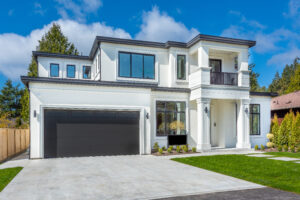The Ultimate Guide to Draining Water from a Flat Roof

*Updated August 22nd, 2025
Flat roofs, also known as low-slope roofs, are a common feature in many commercial and residential buildings. Unlike a traditional sloping roof, a flat roof has only a minimal slope, often ranging from a quarter-inch to half an inch per foot. This design allows for efficient use of space and provides a platform for rooftop installations, such as HVAC units or solar panels.
While flat roofs offer many advantages, they can also present unique challenges—especially when it comes to drainage. Without a proper flat roof drainage system, water can accumulate on the roof surface, leading to standing water, leaks, and even structural damage.
How to Drain Water From a Flat Roof
A well-designed roof drainage system ensures water is collected and directed safely away from the building. There are three primary drainage options for flat roofs: inner drains, scuppers, and gutters. Each type of drain has benefits and drawbacks, and the best choice depends on the roof design, climate, and maintenance needs.
Inner Drains
Inner drains, often called roof drains, are installed directly on the roof surface. These connect to an interior piping system that carries water away from the roof and into the building’s main drainage system.
Advantages of inner drains:
-
Efficient drainage: Designed to remove water quickly, minimizing ponding and the risk of leaks.
-
Hidden system: The drainage components are concealed, keeping the roof surface clear.
-
Long-lasting: When properly installed with the right slope and insulation, roof drains require minimal upkeep.
Disadvantages of inner drains:
-
Clogging risk: Leaves and debris can block the drain openings, restricting water flow.
-
Maintenance challenges: Accessing a roof drain can be difficult, especially on larger commercial flat roofs.
-
Higher installation cost: A professional contractor must carefully install a drain to ensure effective performance.
Scuppers
Scuppers are openings in the parapet wall or along the edges of the roof. They allow water to flow off the flat roof and into an external gutter system or directly away from the building. Often lined with metal, scuppers protect the roof structure from leaks.
Advantages of scuppers:
-
Simple and effective: A straightforward way to drain water off a roof.
-
Visible water flow: Easy to spot blockages or water backup.
-
Cost-effective: Less expensive to install than interior drainage systems.
Disadvantages of scuppers:
-
Limited capacity: May not handle large volumes of water or heavy rainfall.
-
Blockage risks: Debris can cause water pooling on a flat roof.
-
Aesthetics: Some owners dislike the look of exposed scuppers and external drainage.
Gutters
Gutters are one of the most common drainage solutions for flat roofs. Installed along the edges of the roof, they collect water and carry it to downspouts that move the water away from the roof.
Advantages of gutters:
-
Versatile: Can be installed on almost any roof type.
-
Familiar: A widely recognized type of drainage system for both homes and commercial buildings.
-
Effective: When clear, gutters efficiently direct water and prevent water buildup.
Disadvantages of gutters:
-
Maintenance: Gutters must be regularly cleaned to prevent clogs and water damage.
-
Potential leaks: Old or poorly installed gutters can develop leaks.
-
Exposure: Visible gutters and downspouts may affect building aesthetics.
Choosing the Right Flat Roof Drainage Solution
Selecting the right flat roof drainage system requires considering cost, durability, and maintenance.
1. Price
-
Inner roof drains are often the most expensive to install.
-
Scuppers are the most affordable.
-
Gutters fall somewhere in between.
2. Durability
-
Flat roof drains and siphonic roof drainage systems are highly durable when properly maintained.
-
Scuppers can be vulnerable to weather and impact.
-
Gutters work well but may require more frequent repair or replacement.
3. Maintenance
-
Inner drains require less upkeep, provided debris doesn’t block them.
-
Scuppers and gutters need more frequent inspections to prevent standing water or leaks.
-
In some cases, tapered insulation may be installed to facilitate water runoff and reduce maintenance needs.
FAQs on Flat Roof Drains
Q: How often should I inspect my flat roof drainage system?
A: At least twice a year—ideally before and after rainy seasons. This helps prevent water pooling on a flat roof and reduces the risk of leaks.
Q: Can I install a flat roof drain system myself?
A: While DIY is possible, hiring a roofing contractor ensures proper drainage. Improper installation can lead to structural damage and costly repairs.
Q: How long does a flat roof drainage system last?
A: On average:
-
Inner drains: 20–30 years
-
Scuppers: 15–25 years
-
Gutters: 10–20 years
Q: What about siphonic drainage systems?
A: A siphonic roof drainage system uses a vacuum effect to move large water volumes efficiently through smaller pipes. They’re common in large commercial buildings and reduce the need for multiple external drains.
Get Professional Help
Flat roofs need a proper drainage system to avoid water damage, leaks, and standing water on a flat roof. Whether you’re considering scuppers, gutters, or roof drains, a professional roofer can help design and install the best flat roof drainage solutions for your building—keeping water away from the building and ensuring your system remains reliable for years.
Additional Roofing Resources
- Homeowner’s Guide to GAF Shingles
- Top Causes for Brown Spots on Your Ceiling
- The Ultimate Guide to Impact-Resistant Roofing Materials

Anna has over six years of experience in the home services and journalism industries and serves as the Content Manager at MyHomePros.com, specializing in making complex home improvement topics like HVAC, roofing, and plumbing accessible to all. With a bachelor’s degree in journalism from Auburn University, she excels in crafting localized, comprehensive guides that cater to homeowners’ unique needs. Living on both coasts of the United States has equipped her with a distinctive perspective, fueling her passion for turning any house into a cherished home through informed, personalized decision-making.








